Vera and Donald Blinken Open Society Archives
Protesting at Babyn Yar
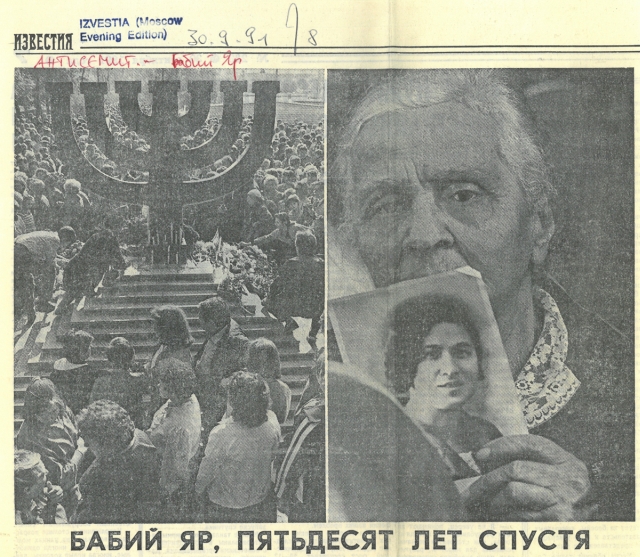 On view at the Blinken OSA Archivum, the exhibition Commissioned Memory - Hungarian Exhibitions in Auschwitz, 1960/1965 debates whether to what extent was the memory of the Holocaust silenced in Socialist Hungary. The exhibition reconstruct two 1960s fine arts projects commissioned by the Hungarian state, which hint at an official memory politics regarding the genocide of European Jews. It is essential, however, that the wide Hungarian public had no real chance of seeing these works back in the 1960s, as they were put on display in Auschwitz. The current exhibition provides an opportunity to further discuss the retraction of memory about the Holocaust in Eastern Bloc countries.
On view at the Blinken OSA Archivum, the exhibition Commissioned Memory - Hungarian Exhibitions in Auschwitz, 1960/1965 debates whether to what extent was the memory of the Holocaust silenced in Socialist Hungary. The exhibition reconstruct two 1960s fine arts projects commissioned by the Hungarian state, which hint at an official memory politics regarding the genocide of European Jews. It is essential, however, that the wide Hungarian public had no real chance of seeing these works back in the 1960s, as they were put on display in Auschwitz. The current exhibition provides an opportunity to further discuss the retraction of memory about the Holocaust in Eastern Bloc countries.
Auschwitz stands as a globally recognized symbol of genocide, where, in an extermination camp operated by Nazi Germany, more than one million people were murdered within five years. Beyond a symbol of ethnic cleansing, however, Auschwitz is also a symbol of changing political and memory regimes deciding whose deaths and crimes shall be remembered, and whose forgotten. The former camp was transformed into a memory site soon after it had been liberated. But in Socialist Poland or Hungary, for instance, in the rhetoric of Anti-Fascist struggle, the victims were Polish or Hungarian citizens, not Jews. In Eastern Bloc countries, only after the end of the Cold War have Jews been openly acknowledged as the main target group of Nazi genocide, who perished in Auschwitz in the largest numbers. Numerous extermination camps and death sites in Poland, Czechoslovakia, Germany, or the Soviet Union have been interpreted and reinterpreted in the decades after WWII, as well as after the end of the Cold War. An essential element of this interpretation was—and remains to be—the dilemma of agency. Who decides what a death site represents? Who decides what and how to commemorate? To whom does the memory of the killing belong?
One death site in Eastern Europe stands out for such decades-long contestations; Babyn Yar, a ravine in Kyiv, where German soldiers killed 33,771 Jews in 36 hours between September 29 and 30, 1941, and continued murdering more than 100,000 more people—Jews, Romani, the mentally ill, Soviet POWs, and Ukrainian communists—until 1944. In spring 2022, a Russian missile hit the area near what is today a Holocaust memorial; besides causing international outrage, the incident connected past and current war crimes.
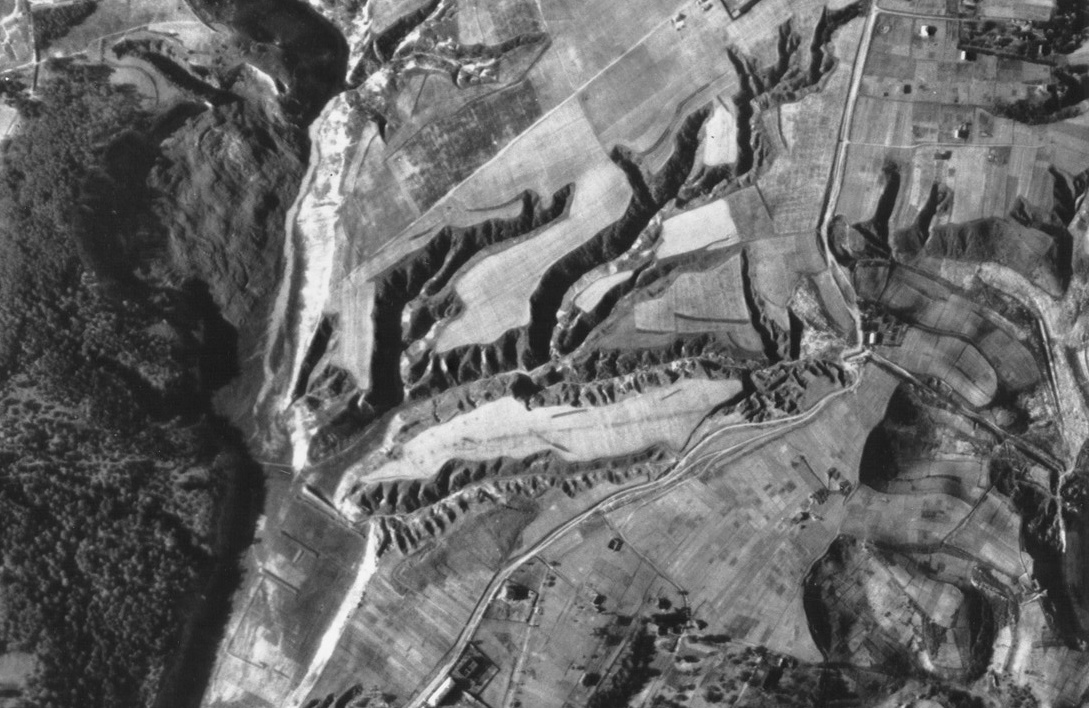 Luftwaffe aerial photograph of Babyn Yar, 1943
Luftwaffe aerial photograph of Babyn Yar, 1943
(Photo: Wikimedia Commons / United States Holocaust Memorial Museum)
In the decades after the Nazis retreated from Kyiv, the site was a symbol of contestation between an authoritarian and anti-Semite state and its desire to conceal memory (and the identities of the victims), and between grassroots memory activism. The aftermath of Babyn Yar, as captured in archival evidence preserved at the Blinken OSA Archivum, involves state apparatchiks, Soviet secret services, dissidents, nationalists, protesters, and the international community.
Cultural and literary responses to the 1941 shootings and the subsequent atrocities appeared early after WWII, in poems and texts by Yiddish, Russian, and Ukrainian authors. A milestone in this was the 1961 publication of Yevgeny Yevtushenko’s poem Babi Yar, in the leading Russian periodical Literaturnaya Gazeta. Beginning with the line “No monument stands over Babi Yar,” the poem was a cry addressed not only to perpetrators, but to the Soviet Union as the state that—having been one of the winners of the war—bore responsibility to preserve the memory of its perished citizens. Yevtushenko identified himself with Jewish victims, despite being of Russian origin. While Babi Yar interpreted the massacre as a universal tragedy not limited to a single ethnic group, at the same time it demanded that Jews be recognized as its victims, emphasizing the targeted nature of Nazi genocide. The poem was circulated in samizdat, and later performed by Yevtushenko at public readings and on radio, including Radio Liberty. Evoking high emotional response among Jews across the Soviet Union and beyond, the poem was set to music by world-famous composer Dmitri Shostakovich in his Thirteenth Symphony, subtitled “Babi Yar.” Many Soviet Jews referred to Yevtushenko’s poem in various samizdat texts, as part of the Jewish movement in the USSR. One of the major aims of this movement was to ensure that the USSR respect Jews’ right to mobility, including their emigration from the country. Yet, the concerns of Jewish identity and the identities of those perished in the Holocaust was also getting more and more attention within the movement.
Babyn Yar, however, gained symbolic meaning not only among the Jewry. Since 1964, Kyiv authorities have permitted citizens to gather September at the site of the killings every to commemorate victims. Two years later, on the 25th anniversary of the September 1941 shootings, Ukrainian poet Ivan Dziuba made a speech—a political statement, rather—at Babyn Yar. Dziuba linked Jewish victimhood, silenced by the Soviet authorities, with Ukrainian nationalism, emphasizing that the tragedy happened on Ukrainian land. He considered Babyn Yar of universal importance, a tragedy of all mankind; yet, he claimed that it had special meaning for Jewish and Ukrainian people. The full speech was published abroad (in 1967 and 1968), in the USSR it was circulated in samizdat (in 1976).
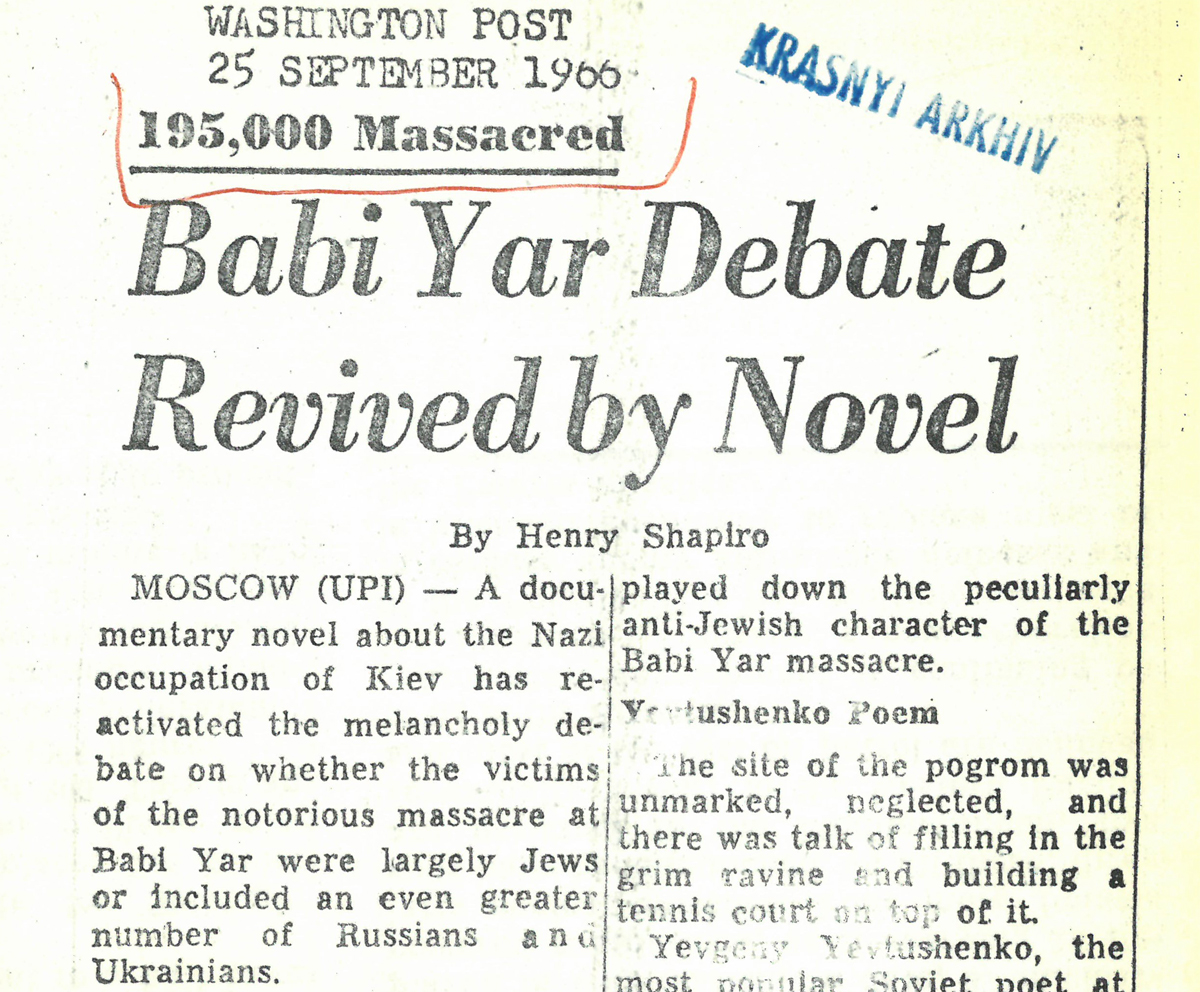 Press clipping from the RFE/RL Research Institute’s compilation on anti-Semitism and Babyn Yar.
Press clipping from the RFE/RL Research Institute’s compilation on anti-Semitism and Babyn Yar.
(HU OSA 300-80-1, Records of RFE/RL Research Institute, Soviet Red Archives, Old Code Subject Files)
At the same time, the official Soviet press was not completely silent about the massacre either. Yet, it subjected it to the state narrative about WW2, with the victory of Soviet people as its culmination. The same year as Dziuba’s speech, in 1966, a censored version of a documentary novel Babi Yar: a Document in the Form of a Novel by Anatoly Kuznetsov was published in the monthly literary magazine Yunost’. Three years later, in 1969, Kuznetsov defected from the USSR to the West, bringing with him the uncensored manuscript on film. He published the original version, first under pseudonym in New York, but later even read it out on Radio Liberty. An eyewitness account, his novel became one of the most known and acclaimed responses to the 1941 massacre internationally.
The political significance of Babyn Yar took another turn with the Six-Day (Arab–Israeli) War of June 1967. Israel’s swift victory triggered impetus in the Soviet Jewish movement, and texts about self-identification of Soviet Jews, close ties to Zionism, and references to the Holocaust appeared in samizdat more often. With Soviet–Israeli relations severed and diplomatic relations between the two countries cut off (the Soviet government supported a coalition of Arab states with arms and training), the so-called “Jewish question” in the USSR gained even more gravity.
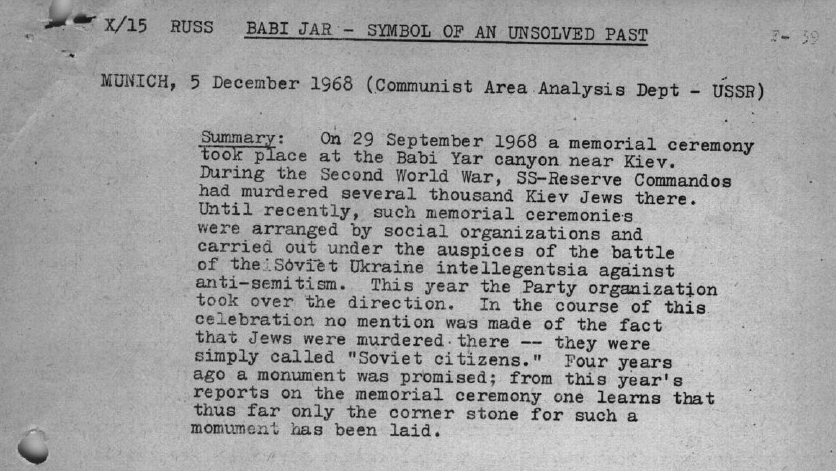 Background Report on the 1968 commemorations, produced by RFE/RL’s Communist Area Analysis Department in 1968.
Background Report on the 1968 commemorations, produced by RFE/RL’s Communist Area Analysis Department in 1968.
(HU OSA 300-8-3 Records of RFE/RL Research Institute, Publications Department, Background Reports)
In 1968, Kyiv authorities took control of the September commemorative ceremony at Babyn Yar, in order to prevent problematic accounts—such as those of 1966—even arranging arrests and a trial. The ceremony was officially dedicated to the “memory of Soviet soldiers and citizens” murdered by Nazis, not mentioning the ethnic origins of some of them. Typical of the Cold War, the officials used the ceremony to condemn the West for the war in Vietnam or the foreign policies of Western Germany and Israel. Reporting on the political tension surrounding the memorial ceremonies, an RFE journalist called Babyn Yar “a symbol of an unsolved past.”
The following years saw the repeating practice of parallel commemorations at Babyn Yar, with a rupture between an official memorial rally at Babyn Yar and a subsequent grassroots one. People gathered at the site first listened to official speeches, then quietly commemorated their friends and family members who had fallen victim to the genocide; recollection of the 1969 ceremony was included in the first issue of Iton, a Jewish samizdat periodical.In 1971, on the 30th anniversary, about 300 uniformed policemen, 2,500 Jews and 500 non-Jewish visitors attended the ceremony. No incidents were reported, despite the fact that one month earlier, in August 1971, twelve Jews were detained for staging a protest prayer meeting at Babyn Yar, after their application to emigrate to Israel had been refused, thus becoming refuseniks. In 1973, Western journalists noted police tearing up wreaths and stepping on candles lit by about 1,000 Jews who had gathered to commemorate at the site; four people were arrested. In 1974, 300 policemen surrounded the site, before permitting the laying of wreaths. The dedication “To the Jews of Babyn Yar from the Jews of Moscow and Riga,” was removed from one.
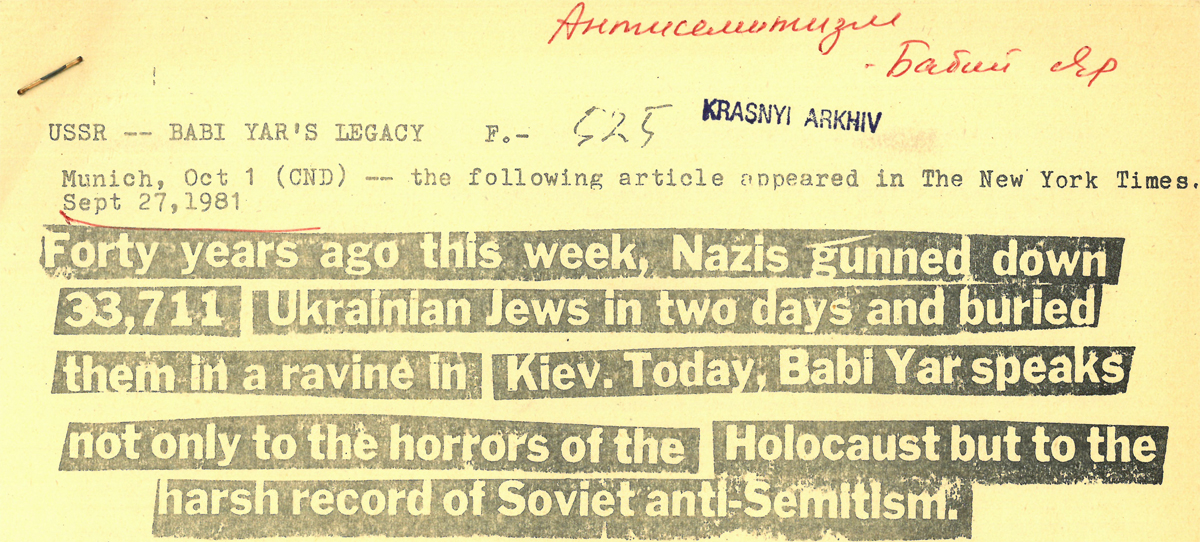 Press clipping from the RFE/RL Research Institute’s compilation on anti-Semitism and Babyn Yar.
Press clipping from the RFE/RL Research Institute’s compilation on anti-Semitism and Babyn Yar.
(HU OSA 300-80-1, Records of RFE/RL Research Institute, Soviet Red Archives, Old Code Subject Files)
To mark the 35th anniversary of the massacre in 1976, a monument was finally erected at the site: a large bronze sculpture of 11 heroic figures, including a woman on top with her hands bound with barbed wire. Its inscription failed to mention Jews as victims, only Soviet citizens of Kyiv and prisoners of war. The same year, Kyiv Jews informed the Western press of a police warning to stay away from Babyn Yar during the September commemoration, as “if you even try to visit, you’ll be arrested, not just briefly but for many years.” The 40th anniversary, in 1981, was no different; several Jews from Odesa, Moscow, or Leningrad, were prevented from travelling to Kyiv, some were arrested.
Jews were executed in the largest number at Babyn Yar, however, they were not the only targets of the killings; yet, one cannot help but notice that the decades of protest to honor the memory of the victims seem to have been concerned only with the memory of Jewish victims, and not that of other groups. In 1991, once the Cold War ended and the Soviet Union collapsed, a new monument in the form of a menorah was inaugurated at Babyn Yar, clearly indicating the identity of Jews executed here. However, as victims fell into several categories, numerous new monuments were raised in the years that followed. The site became a polyphonic place of memory and did not escape the turbulence of contestation in the so-called “memory wars” in post-1991 Ukraine. Recently, in search of an alternative interpretation of the site, plans were discussed to establish Europe’s biggest Holocaust museum in Kyiv.
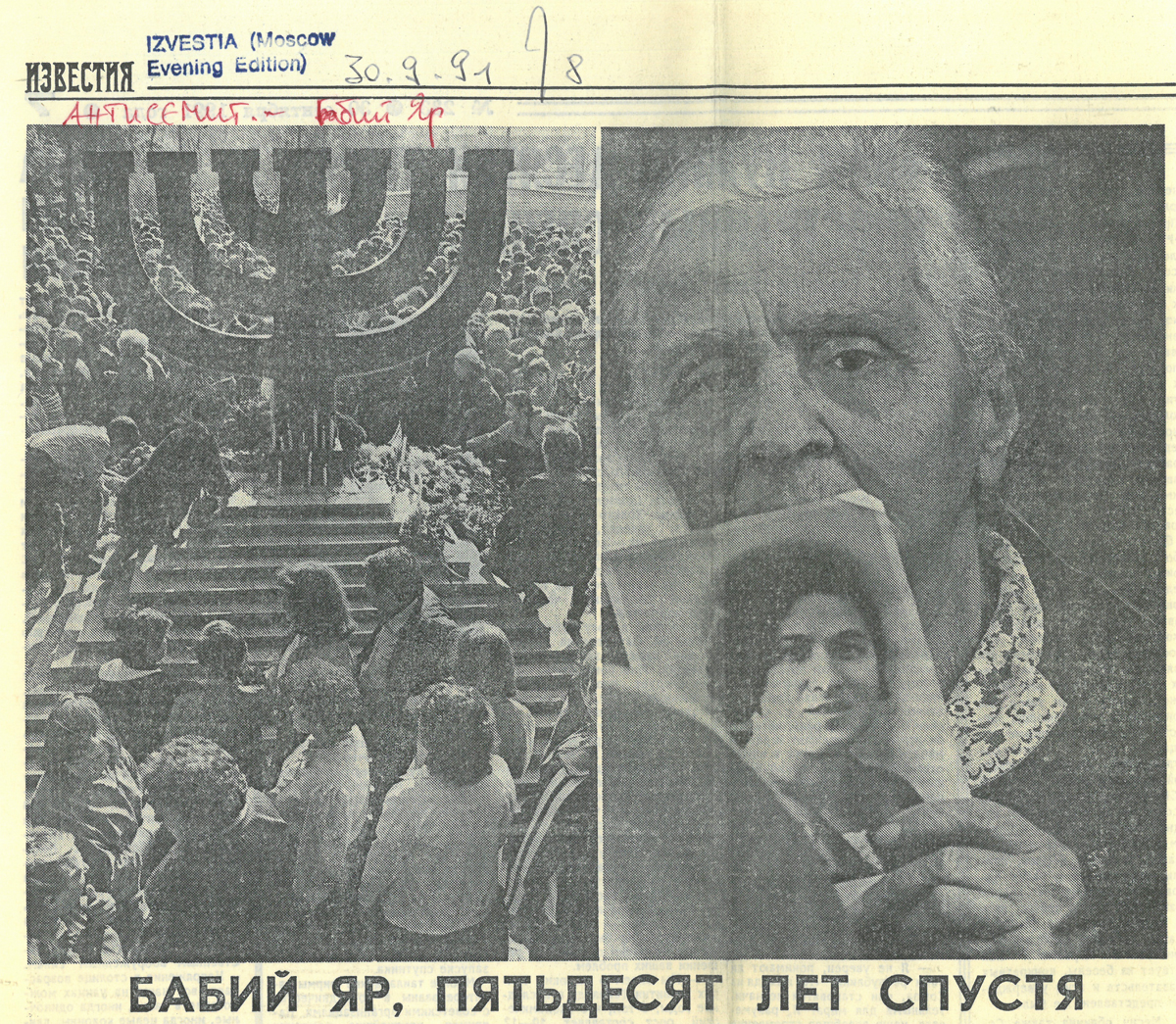 Press clipping from the RFE/RL Research Institute’s compilation on anti-Semitism and Babyn Yar.
Press clipping from the RFE/RL Research Institute’s compilation on anti-Semitism and Babyn Yar.
(HU OSA 300-80-1, Records of RFE/RL Research Institute, Soviet Red Archives, Old Code Subject Files)
The current Russian invasion of the country impacts the very lens through which the killings’ site will be further interpreted among Ukrainian citizens. A recent example of this is a June 2022 suggestion by the Ukrainian Ministry of Education and Science to remove Kuznetsov’s novel from the school curriculum (along with many other Russian, Belarusian, and Soviet authors). Instead, teaching about the Holocaust would rely on the Irish writer John Boyne’s 2006 novel The Boy in the Striped Pyjamas, set in Auschwitz. Boyne replacing Kuznetsov, and Auschwitz replacing Babyn Yar may be seen as a sign of universalization of Holocaust memory, to which Ukraine is subjected to as much as many other countries globally. The question remains, though, whether these new layers of memory will or will not overshadow the memories of those who, in spite of persecutions and arrests, for decades kept protesting at Babyn Yar.

